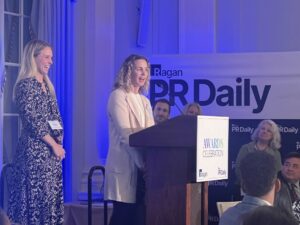6 tips for more effective wellness communications
Two companies share communication methods for stronger wellness engagement.

Mid adult Asian businessman and his team of business professionals working together in co-working office.
Any wellness program, from financial planning, to steps competitions and mental-health support, depends on communications. It’s really that simple. The best plans and programs won’t succeed if employees are disengaged or unaware.
With so many wellness programs more common and the offerings more robust than ever, it’s essential for wellness managers to communicate all aspects of their programs to the right audiences to reach engagement goals and see a healthier workforce.
Some data suggests the opposite is happening. A recent Quantum Health survey of 1,000 consumers with employer-sponsored health insurance found employers are struggling to understand and engage with their benefits, resulting in loss of productivity and higher stress. So in this context, it’s valuable to look at what’s working. Some industry-wide best practices for wellness communications include:
- A dedicated intranet page or website.
- Wellness champions or liaisons.
- A messaging strategy that goes beyond enrollment.
- Leadership buy-in.
- Apps that ping users.
- Measurements to create data-driven improvements.
“If a program ends up being forced or communicated so specifically that it tries to dictate what wellness is for each employee, it will ultimately fail to engage them or reach them in a meaningful way,” says Megan Jones, vice president of marketing and partner at January Digital, a consultancy with offices in New York City and Dallas.
Champions keep the conversation going
One award-winning wellness program with a strong communications component is High Point University, located in High Point, North Carolina. The university’s wellness efforts serve 1,000 employees across the campus. Most employees returned to on-site work in August 2020, with 98% of staff and faculty on campus.
Wellness program director Melissa Marion uses several techniques for effective communication, including a well-defined strategy and wellness champions. In a recent survey, 90% of employees who responded said the wellness program was well communicated.

Two major components of Marion’s strategy are a weekly wellness “toolkit” email and an email campaign for new hires. The weekly toolkit was inspired by the pandemic-induced shift to all-virtual offerings, as on-site classes and the fitness center closed temporarily. The response was so positive that Marion has added it permanently to her program’s communication strategy. The toolkit is distributed to a subscriber group on Mondays. It includes news, reminders, and links for easy access to resources. The information covers all aspects of wellness, from nutrition to mental health. A parenting link helps support caregivers struggling with remote work.
A monthly campus-wide email newsletter goes out with wellness reminders for another layer of marketing.
Marion wanted to make sure new employees were aware of wellness programing right from the start, even as they despite being swamped with all kinds of information during onboarding. She designed an email campaign that reaches out to new hires monthly for their first three months.
The first month’s email offers a checklist of actions to get started on wellness programs. Month two refers to month one’s checklist and adds a list of university professional services, like nutrition counseling, pools, and health and wellness coaching. The third month reiterates the previous two months’ information and lists events going on that month and a call to action to reach out for assistance.
“If we don’t catch them when they’re new, it’s hard to catch them down the road,” Marion says. “Starting a new job often means starting new habits, whether we realize it or not.”
Marion says High Point’s registration portal sees a 25% leap in enrollment with the emails. Overall, the wellness program has anywhere from 50% to 75% enrollment, after pandemic fluctuations.
Following the email campaigns, Marion uses wellness champions to keep the conversation going after enrollment. The champions are often used as liaisons to the employees to advocate for healthy living and the program’s resources throughout the year. They also provide feedback from employees and offer suggestions for program directors.
There are currently 23 wellness champions at HPU, but Marion would like to add seven more. Champions are divided among the university’s academic schools and administrative departments. Marion says they help build wellness through personal connections. “Champions help connect and create that social atmosphere and relationship back to employee wellness,” she says.
Strategy raises engagement
Meanwhile, a much smaller organization, January Digital, launched a wellness program called “Well Works” last year, and with it, a communications program designed to maximize awareness. Jones says 40% of employees signed up in the first month. More than 70% engaged with its mental-health resources.

The program offered monthly educational and training events, an online therapy tool called SPILL, and yearly stipends for personal mental, and physical, emotional and spiritual support. “We’ve had good adoption across our offerings since its launch, and we continually see an uptick in participation each time we tease a new feature or send reminders of what we offer,” Jones says.
The company’s communication strategy keeps the wellness program at the forefront. It features quarterly learning sessions from a therapist connected to employees via the mental-health tool. This reminds employees of its availability. Jones says there’s higher engagement after every session.
Testimonials from coworkers drive cultural change and destigmatize tough conversations. Jones says these endorsements not only help remind employees of the offerings but provide feedback on the program to management. Leadership testimonials demonstrate a wellness buy-in that can have a powerful impact on engagement.
Jones says Well Works is also measured annually through an employee feedback survey. With measurement, it has discovered that some of its most-used programs are not the most impactful on workplace wellness.
Regular wellness program communications also include an update in the weekly newsletter to advertise regular events and share employee testimonials.
COMMENT
Ragan.com Daily Headlines
RECOMMENDED READING
How I got here: Joel Johnson on the key to excellence in storytelling
How to beat boredom and recapture the joy of writing
Tags: communications, engagement, High Point University, January Digital, megan jones, melissa marion, strategy, Wellness






